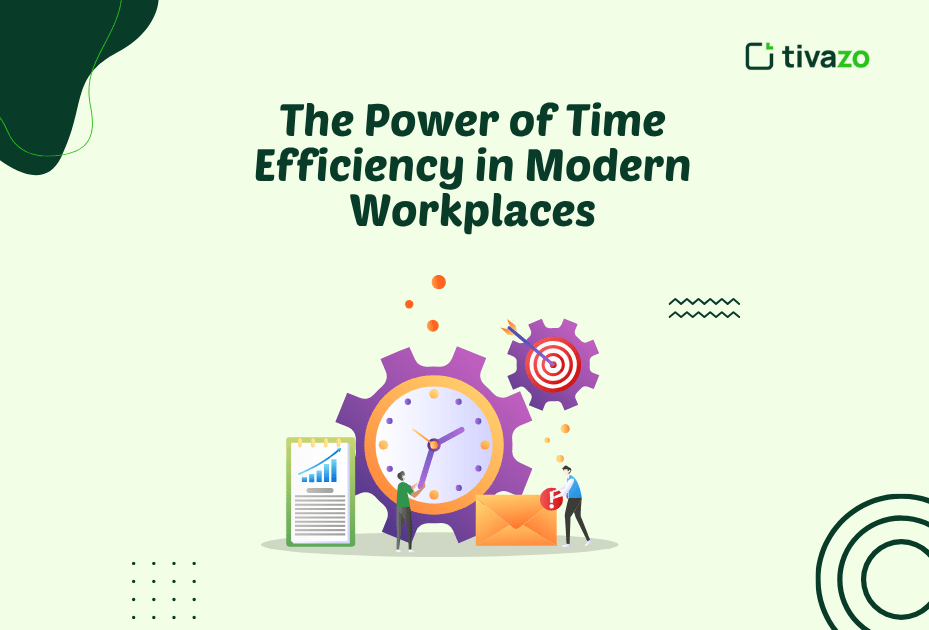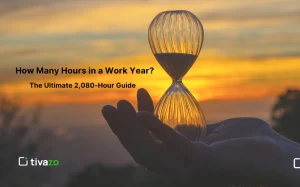Because life and work move so quickly and set high demands these days, being efficient with time matters a lot for both individuals and companies. It supports positive productivity, the achievement of objectives, and a healthy way of living. Exactly, what is time efficiency? Why is the issue significant? And what can you do to upgrade it using various effective methods and approaches?
This blog dives into, explains the formula in detail, outlines smart ways to work, and explains how Tivazo can change the way you handle work tasks.
What is Time Efficiency?
Time Efficiency means completing duties in less time yet maintaining excellent results. It shows the efficiency of time used by individuals or organizations to accomplish what they want. In summary, the point is to speed things up and still maintain the proper standard of service.
To be efficient with time, you don’t have to hurry or skip important steps. Instead, you should put in place a plan, pick what’s important first, and put it into action. Time management combines discipline, attention, and the proper tools to make sure time is not wasted and productivity increases.
The Time Efficiency Formula
We can analyze time efficiency by using the time efficiency formula.
Time Efficiency (%) = (Time Spent on Productive Tasks / Total Time Available) × 100
This equation tells you how much of your time is spent doing things that count. Time efficiency for someone using 6 out of 8 hours on tasks that matter is:
(6/8) × 100 = 75%
This metric allows organizations to find areas where they are not working at top efficiency, improve their planning, and make wiser decisions.
Benefits of Time Efficiency

1. Enhanced Productivity
When workers complete tasks efficiently, they meet all their requirements within the work hours, and they do not need to work overtime. It makes the production of results more efficient and helps keep the team going.
2. Cost Reduction
When operations are time-efficient, they result in fewer delays, less repetition, and saved resources. Making workflows less complex allows organizations to cut costs and boost their profit.
3. Better Decision-Making
Leaders can find out what makes some projects or tasks more productive by observing how time is divided. Having these insights, decisions can be made quicker and in line with the business’s overall goals.
4. Improved Team Collaboration
When time is organized well, it helps people organize their schedules, communicate more clearly, and delegate duties among themselves. As a result, team members work more together, avoid confusing each other, and become more accountable.
5. Higher Employee Satisfaction
A well-organized approach prevents last-minute pressure, hard work, and fatigue. If employees handle their own time, they are more satisfied and connected to their work.
6. Work-Life Balance
Effective organization at work and good time management allow employees to concentrate on their personal affairs outside work. Doing both activities helps people maintain sound mental health and remember things for a longer period.
7. More Accomplished and Swifter Results
Making work more efficient enables daily activities to further the main objectives held by the organization. Clearing away distractions and delays allows teams to reach their targets and important goals faster than before.
8. Competitive Advantage
Being fast is very important in industries that move quickly. If a company manages its timings properly, it can easily switch its activities, begin new ventures promptly, and react to market changes before anyone else. Being efficient with time gives companies an advantage.
Strategies to Maximize Time Efficiency

Maximizing time efficiency requires several approaches. Here are several time-saving strategies that can significantly enhance productivity:
1. Prioritize Tasks
Importance varies from one task to another. Using frameworks like the Eisenhower Matrix (urgent vs. important) or ABC prioritization (categorizing tasks by importance) can assist you in staying on top of what you should deal with immediately, unlike reacting to anything that gets the most attention at that moment.
Tip: Ask yourself, “What has the biggest impact today?”
2. Set SMART Goals
Setting specific goals shows you where you need to head. SMART goals are defined by the following:
- Specific – Outline what action is required
- Measurable – Measure the outcomes with numbers
- Achievable – A realistic and workable objective
- Relevant – Aligned with broader objectives
- Time-bound – Have a defined deadline
Tip: Instead of being a random group of duties, your to-do list becomes a plan to follow with SMART goals.
3. Use Time Blocks
In time blocking, you arrange your time to address specific jobs or categories of work for a fixed amount of time. As a result, you focus on one thing at a time, which allows important things to get proper attention.
Tip: Try to block 9–11 AM for uninterrupted work, schedule your meetings for 1–2 PM, and so on.
4. Eliminate Distractions
Distractions can easily steal a lot of time from you without you noticing. You might want to use web blockers, Do Not Disturb features, and apps such as Forest, Focus@Will, to maintain your concentration.
Tip: Arrange your surroundings, mute your gadgets, clean your work area, and share when you are available with your colleagues.
5. Delegate Tasks
The key to delegation is to make sure you get the most out of what your team can achieve. Find work that someone else can do as effectively (or even better) so you can put your attention on more important duties.
Rule of thumb: A good principle is to let someone else handle a task if they can do it 80% as well as you can.
6. Leverage Technology
Take advantage of tools that can simplify or handle the same task more than once. Email filters, CRM programs, and management apps (for example, Trello, Asana, Notion) relieve manual duties and increase cooperation among the team.
Bonus: In addition, AI-assisted tools can be used for writing, scheduling tasks, or creating summaries.
7. Continuous Improvement
Time management isn’t a skill you can ignore after setting it up. Make sure to keep identifying which strategies are fulfilling their goals and which are not.
Ask:
- What activities eat up my time?
- What process can be simplified?
- Which tasks can we get rid of completely?
Just one percent more can make a big difference over time
8. Take Regular Breaks
It is normal for the brain to get tired after spending too much time trying to focus. By following the Pomodoro Technique (25 minutes of work followed by a 5-minute break), you can stay focused and alert all day. Taking a brief break can help you think clearly again and keep you from burning out.
9. Maintain a Calendar
A calendar that is easy to use functions as your memory. Plan meetings, time slots for different tasks, upcoming deadlines, and time for you. Apply color-coding and use visual reminders so that tasks are separated and you don’t forget anything.
Tip: Check your calendar every week to help you plan future events and activities.
10. Track Your Time
You can use Toggl, Clockify, or RescueTime to analyze your actual working hours and see where your time goes. Most of the time, we appear to know all the details, but the data exposes the truth. This understanding helps you get rid of unimportant work so your daily schedule is aligned with your goals.
Case Studies: Real-Life Impact of Time Efficiency Policies
Businesses in different industries are now using time efficiency programs to achieve better outcomes. Here are four true stories that explain how different teams improved their work by using better time management techniques:
Case Study 1: Software Development Team Improves Project Delivery

The company rolled out a live task tracking system for all development and QA teams. Between one and three months, the company managed to increase its time efficiency and improved the rate of finishing projects by 27%.
Key changes:
- The review times shown on the daily time logs pointed out areas where the team struggled.
- With the help of idle time reports, managers could reassign their employees’
Result: There are shorter sprint planning times, and delays are avoided.
Case Study 2: Online Education Team Increases Teaching Time

Within a big education network, an e-learning section started using automatic reports to check daily roles and responsibilities among the instructors and employees. They noticed they could teach their students for 20% more time, as they got rid of some unnecessary administrative work within only two months.
Result: After the change, more attention was given to getting lessons ready and instructing students, which boosted their engagement.
Case Study 3: Hospital Reduces Administrative Task Time
A hospital in the region started using monitoring tools to review how the administrative team used their time on the job. With the analysis of trends and improved desk procedures, they managed to spend 30% less on paperwork and system input.
Result: The staff became more accessible to care for patient,s and services improved while the team was kept at its original size.
Case Study 4: Marketing Team Boosts Output Without Compromising Privacy
A creative agency handling multiple client accounts started using live screenshot monitoring in addition to screenshot masking to maintain secrecy without hiding anything. After achieving this balance, the team enjoyed an 18% rise in productivity during the first quarter.
Result: The team could follow the advancement of tasks, sort out any delay,s and keep data reliab,le which also helped develop a better performance culture.
Improve Your Time Efficiency with Tivazo Time Tracking Software

You can transform your time management by using Tivazo. Now, we will look at what features make time efficiency possible in businesses.
1. Real-Time Tracking
It enables you to view your projects in real time. Once you are aware, at each moment, about how much time is spent on each task, you can quickly correct or improve as needed. This approach helps you become more motivated and focused on your work.
2. Idle Time Tracking
Tivazo identifies when your computer remains idle during working hours. It collects information on times when there is no work being done, making it possible for users to notice and avoid wasting time.
3. Report Generation
When your reports are customizable and automated, generating detailed reports on productivity becomes possible. Organizations can use these reports to analyze how work time is spent, which helps them make decisions.
4. Screenshot Masking
Through this entry point, data security is possible by concealing important information in pictures taken from the screen. It manages employee privacy together with close monitoring to ensure the company is trustworthy and maximizes time efficiency.
5. Live Screenshots
You can see who is using your site and what they do using live screenshot technology. Thus, it supports transparent work and can be handy for both managing teams and working from a distance.
Final Thoughts
Time Efficiency is important in today’s work environment. Whether you are a solo team, a new venture, or an established company, time efficiency helps you achieve success. You can greatly enhance your productivity and do more in a shorter period by working with the time efficiency formula, using set strategies, and supporting yourself with advanced tools like Tivazo.
Kick off your good time management practices today. Since moments keep going, forever moving forward, cherish each one




